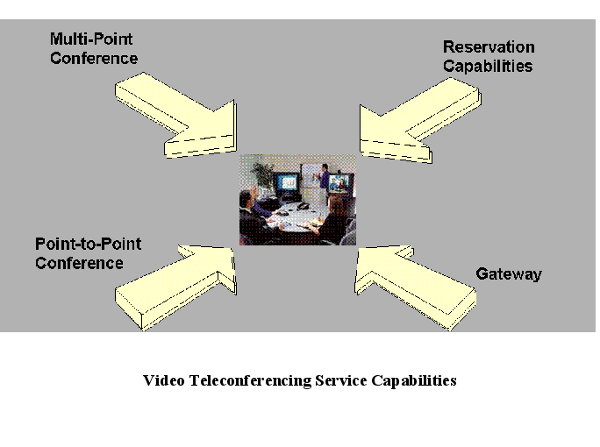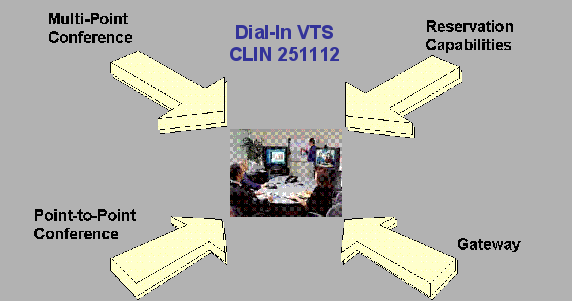VTS supports diverse Agency video teleconferencing needs, such as conferencing, distance learning, remote testimony, and other applications. This service enables participants at different locations worldwide to simulate face to face meetings and conduct interactive dialogue with instant sharing of various applications and documents. VTS supports desktop-PC, portable roll about, and fixed conference room for point-to-point and multi-point conferencing with audio conference add-on capabilities.
VTS is an application-layer service that uses underlying network service(s) to carry video traffic. VTS can operate over circuit-switched networks and Internet Protocol (IP) networks, including the Public Switched Telephone Network (PSTN) and other Networx contractor's networks. Networx Circuit Switched Data Service (CSDS), Network-Based IP VPN Service (NBIP-VPNS), and Private Line Service (PLS) can provide connectivity to the contractor's multipoint video conferencing bridge. VTS provides appropriate adapters and gateways for coding conversion, video format conversion, rate adaptation, protocol conversion, and dissimilar networks.
The diagram below shows the various capabilities of VTS, such as point-to-point and multi-point video conference, reservation, and gateway capabilities.

VTS is similar to Video Teleconferencing Service on the FTS2001 contracts. It supports the full range of technical capabilities that are available in commercial offerings. These capabilities include:
These and other service capabilities are detailed in Section C.2.8.1.1.4 Technical Capabilities of the Networx contracts.
VTS also offers features that complement the basic service. These features are described in Section C.2.8.1.2 Features of the Networx contracts and are listed below:
Each Networx contractor may provide variations or alternatives to the offering and pricing for VTS. The specific details can be found within each Contractor's Networx contract and pricing notes for VTS.
For more information on the general VTS specifications and requirements, please refer to Section C.2.8.1 of the Networx contract for technical specifications and Section B.2.8.1 for pricing.VTS enables participants at different locations to simulate face-to-face meetings and conduct interactive dialogue with instant sharing of documents and applications. VTS conferences are available among two or more locations. VTS' audio conference add-on capability supports non-video conference users via a VTS call. Data connectivity is required for VTS. VTS provides the following components:
Conferences canceled prior to scheduled start time are not billable. After the scheduled start time, all reserved ports and features are billed for the entire reserved duration whether actually used or not. An ongoing conference that is interrupted through no fault of any of the active participating locations is billed at the next lower completed billing increment, and if such an ongoing conference is interrupted in the first billable time increment, there is no billing for any time of that conference session. VTS is similar to Video Teleconferencing Service on the FTS2001 contracts.
Example 1: Dial-In VTS 384 kbps IPS Origination

Each Networx contractor may provide variations or alternatives to the offering and pricing for VTS. The specific details can be found within each Contractor's Networx contract files and pricing notes for VTS.
For more information on the general VTS specifications and requirements, please refer to Section C.2.8.1 of the Networx contract for technical specifications and Section B.2.8.1 for pricing.